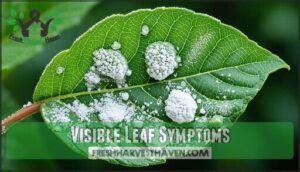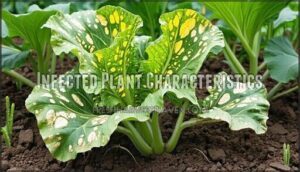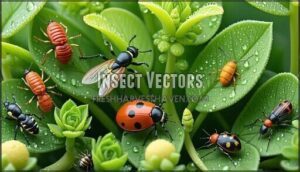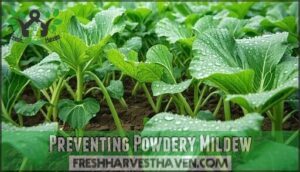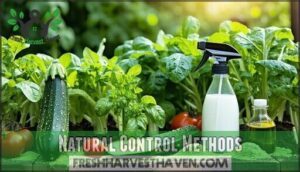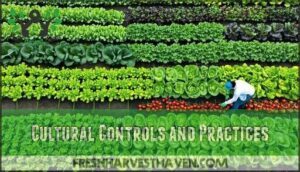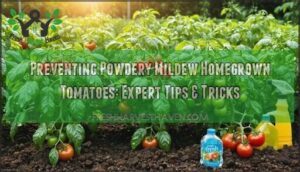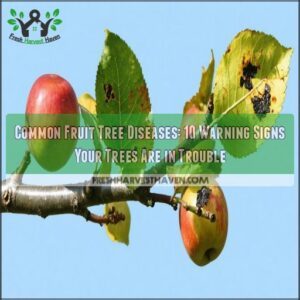This site is supported by our readers. We may earn a commission, at no cost to you, if you purchase through links.
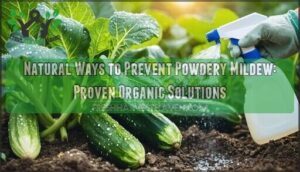 You can prevent powdery mildew naturally by choosing resistant plant varieties and ensuring proper spacing for good air circulation.
You can prevent powdery mildew naturally by choosing resistant plant varieties and ensuring proper spacing for good air circulation.
Plant in sunny locations since the fungus thrives in shade and humidity. Water at soil level in the morning so leaves dry quickly.
Apply preventive sprays like diluted baking soda solution, neem oil, or milk spray weekly during humid conditions. Remove infected leaves immediately and clean up fallen debris to break the disease cycle.
Mulch around plants to prevent soil splash, and avoid over-fertilizing with nitrogen which creates tender growth that’s more susceptible. These simple steps create an environment where powdery mildew struggles to take hold, but timing and technique make all the difference, and following these steps with proper spacing and good air circulation will help prevent powdery mildew.
Table Of Contents
- Key Takeaways
- What is Powdery Mildew
- Mildew Symptoms and Signs
- How Mildew Spreads
- Preventing Powdery Mildew
- Natural Control Methods
- Cultural Controls and Practices
- Managing Mildew Outbreaks
- Frequently Asked Questions (FAQs)
- How do you get rid of powdery mildew naturally?
- What is the natural enemy of powdery mildew?
- How to keep plants from getting powdery mildew?
- Is vinegar or baking soda better for powdery mildew?
- Can powdery mildew affect indoor houseplants?
- How does humidity influence mildew prevention efforts?
- Are there companion plants that deter mildew?
- Does crop rotation reduce powdery mildew risk?
- Can natural predators help control mildew fungi?
- Can powdery mildew infect all plant species?
- Conclusion
Key Takeaways
- Choose resistant plant varieties and space them properly—you’ll create natural defenses while ensuring good air circulation that prevents fungal spores from taking hold in humid conditions.
- Apply preventive sprays weekly using a milk solution, baking soda mixture, or neem oil during humid weather—these natural treatments create an alkaline environment that stops spores before they can establish infections.
- Remove infected leaves immediately and practice good garden hygiene by cleaning tools between plants—you’ll break the disease cycle and prevent spores from spreading to healthy areas.
- Water at soil level in the morning rather than using overhead watering—this keeps leaves dry and reduces the humidity that powdery mildew fungi need to thrive and spread throughout your garden.
What is Powdery Mildew
Powdery mildew is a common fungal disease that appears as white, powdery spots on plant leaves, stems, and fruits.
This fungus thrives in warm, humid conditions and spreads easily through wind, insects, and direct contact between plants, making it a highly contagious disease.
Fungal Disease Overview
When you’re dealing with powdery mildew, you’re actually facing a diverse family of fungal diseases from the Erysiphales order.
These fungi aren’t one-size-fits-all troublemakers – they show remarkable host specificity, with different fungal strains targeting specific plants.
The rose strain won’t jump to your cucumbers, and vice versa.
Understanding mildew biology reveals why this fungal disease is so persistent.
These microscopic invaders create specialized feeding structures called haustoria that tap directly into your plant’s cells like tiny vampires.
These fungal freeloaders drain your plants dry while keeping them barely alive.
They steal nutrients while keeping the host alive – a clever survival strategy that explains why disease severity varies between plants.
Most powdery mildew cases stem from Erysiphe cichoracearum, thriving in warm, humid conditions without needing standing water.
This knowledge forms the foundation of effective mildew prevention strategies.
By recognizing these plant diseases early and understanding their unique characteristics, you’ll be better equipped to implement natural remedies that actually work.
Common Host Plants
Understanding which plants face powdery mildew challenges helps you make smarter garden choices. Different species show varying squash susceptibility, rose infections, and lilac mildew patterns based on their genetics and growing conditions.
Here are five common targets:
- Squash – broad leaves trap moisture, creating ideal conditions
- Roses – older varieties lack modern resistance genes
- Lilacs – dense branching reduces air circulation
- Phlox – crowded plantings increase phlox problems
- Bee balm – thrives in humid spots where mildew spreads
Choose mildew resistant plants and resistant plant varieties when possible. Understanding the process of haustorium fungal penetration can further inform your plant selection. Modern plant varieties often include built-in protection against common fungal issues.
Spore Dispersal Methods
Powdery mildew spreads through several spore dispersal methods that make it one of gardening’s most persistent challenges. Windborne spores travel easily on air currents, making Wind Spore Travel the primary transmission route.
These microscopic hitchhikers can drift for miles during breezy conditions.
Insect vectors like aphids and whiteflies carry spores between plants. Water splash dispersal occurs when irrigation or rain bounces contaminated droplets onto healthy foliage.
Human Activity spreads spores through contaminated tools and clothing. Overwintering structures called chasmothecia survive winter, releasing fresh spores each spring.
Understanding these pathways helps you block transmission routes effectively.
Mildew Symptoms and Signs
You’ll notice powdery mildew starts as small white patches on leaves that look like someone dusted them with flour.
These spots quickly spread across the plant, causing leaves to yellow, twist, and eventually drop off if left untreated.
Visible Leaf Symptoms
Early signs appear as white powdery spots on leaf surfaces that look like flour dusting.
These mildew symptoms start small but expand rapidly across foliage.
- White patches develop on upper leaf surfaces, creating the characteristic powdery coating
- Yellowing leaves emerge as the fungus spreads, weakening photosynthesis
- Twisted foliage occurs when leaf spotting becomes severe, causing plant deformity
Lower leaves show symptoms first, with leaf drop following if untreated.
Infected Plant Characteristics
Beyond white patches, infected plants show clear warning signs that reveal powdery mildew’s grip on your garden.
| Plant Part | Symptoms | Severity |
|---|---|---|
| Leaves | Leaf Discoloration, curling, yellowing | Moderate |
| Growth | Stunted Growth, wilting branches | Severe |
| Overall | Plant deformity, reduced vigor | Critical |
You’ll spot twisted leaves that curl inward while Powdery Spots spread across surfaces.
Leaf spotting creates yellow patches before leaves turn brown and drop.
Root Damage occurs as nutrients get redirected to fight infection.
Fruit Impact shows as poor development and reduced harvests when mildew symptoms persist untreated.
Fruiting Structures and Spores
As your plants progress through infection, you’ll spot tiny dark pinhead-sized structures developing within those white patches.
These chasmothecia formations signal the fungus entering its sexual overwintering phase, preparing for next season’s assault.
Here’s what happens during spore development:
- Asexual reproduction creates thousands of mildew spores daily
- Spore germination occurs within hours on susceptible leaves
- Mycelium growth spreads rapidly across plant surfaces
- Fungal spores disperse through wind and water splash
- Spore identification helps distinguish powdery mildew from other diseases
These structures transform from white to yellow-brown, then black as they mature, releasing countless fungal spores ready to infect new plants.
How Mildew Spreads
Understanding how powdery mildew spreads helps you stop it before it takes over your garden.
This fungal disease travels through four main pathways that can quickly turn a small infection into a garden-wide problem.
Windborne Spores
Wind carries powdery mildew prevention challenges directly to your garden.
These microscopic spores travel incredible distances through airflow patterns, making spore identification nearly impossible until infection starts.
Weather influence determines spore viability – dry, warm conditions help them survive longer flights.
Regional spread occurs when neighboring gardens share contaminated air.
Strategic pruning for mildew improves air circulation around plants.
Position susceptible plants where airflow and sunlight naturally discourage spore settlement and germination.
Insect Vectors
Beyond air currents, insects act as living delivery systems for powdery mildew spores. These tiny creatures unknowingly transport fungal spores between plants as they move through your garden.
Aphid Vectors collect spores on their bodies while feeding on infected leaves. Whiteflies Spread the disease as they flutter from plant to plant, carrying spores on their wings and bodies. Thrips Transmission occurs when these slender insects crawl through infected foliage. Pollinator Involvement happens when bees and other beneficial insects visit diseased flowers. Mite Contribution comes from spider mites moving across leaf surfaces.
Understanding these transmission methods helps you develop better powdery mildew prevention strategies:
- Managing insect vectors reduces spore spread between plants
- Controlling aphid populations limits fungal hitchhikers
- Monitoring for pest activity alerts you to potential problems
- Using natural mildew control methods protects beneficial insects
- Implementing organic gardening tips creates healthier plant environments
Effective preventive measures target both the fungus and its insect transporters for thorough garden protection.
Water Splash Dispersal
When raindrops hit infected plants, they create tiny splash dispersal that launches spores up to several feet away.
Droplet size impact matters—larger drops spread spores farther than fine mist. Leaf surface tension helps water bounce off, carrying fungal particles to healthy plants below.
Soil splashback occurs when water hits dirt around infected stems, flinging contaminated particles upward. Overhead watering systems worsen this problem by creating perfect conditions for spore travel.
Switch to drip irrigation methods that deliver water directly to soil, avoiding leaf surfaces entirely. This reduces humidity and dampness around foliage while improving air circulation—all factors that limit mildew growth naturally.
Direct Contact Transmission
Human handling spreads powdery mildew faster than you might think.
Your hands, clothes, and tools become carriers when you touch infected plants.
Crowded plants make this worse since you’re more likely to brush against multiple plants while working.
Pet transmission happens when cats and dogs run through your garden beds.
Clothing contact with infected leaves transfers mildew spores to healthy plants nearby.
Here’s how direct contact spreads the disease:
- Human handling of infected leaves during routine garden care
- Tool sanitation neglect allows spores to jump between plants
- Clothing contact when walking through dense plantings
- Pet transmission as animals move through infected garden areas
Smart gardeners practice sanitation by washing hands and disinfecting tools after each use.
Pruning infected material requires immediate cleanup.
Better air circulation through proper spacing reduces accidental contact transmission.
Preventing Powdery Mildew
Prevention is your best defense against powdery mildew, focusing on creating conditions that discourage fungal growth before it starts.
You can protect your plants by choosing resistant varieties, maintaining proper spacing, and following good garden hygiene practices to prevent the onset of powdery mildew, with prevention being key.
Resistant Plant Varieties
Why struggle with powdery mildew when you can prevent it from the start? Choosing disease-resistant varieties gives your garden built-in protection against this common fungal problem.
Resistant plant varieties contain genetic traits that naturally combat powdery mildew spores. These plants prevent fungal colonies from establishing, reducing your need for treatments. Modern breeding programs have developed cultivars with strong resistance mechanisms for vegetables and ornamentals.
Consider these proven resistant options:
- Vegetables: Cantaloupe, cucumber varieties like Marketmore 76, and squash cultivars show excellent disease resistance
- Ornamentals: Phlox ‘David’, bee balm ‘Jacob Cline’, and zinnia ‘State Fair’ demonstrate natural mildew tolerance
- Trees: Kousa dogwood ‘Milky Way’ offers reliable resistance for landscape plantings.
When selecting varieties, look for labels indicating "PM resistant" or "disease tolerance." Variety selection based on genetic diversity provides long-term garden health. These resistant plants require fewer chemical interventions and reduce maintenance costs while providing reliable protection against powdery mildew outbreaks.
The disease is caused by various fungal species.
Proper Plant Spacing
Overcrowding creates the perfect storm for powdery mildew development.
Proper plant spacing guarantees air circulation flows freely between plants, reducing humidity levels that encourage fungal growth.
Spacing benefits include improved sunlight exposure and airflow optimization.
Plant size determines ideal distances – larger plants need more room for effective mildew prevention and disease prevention strategies.
Sanitation and Hygiene
Good garden hygiene acts as your first line of defense against powdery mildew spores. Clean gardening practices prevent disease spread and protect healthy plants from infection.
Follow these sanitation steps to maintain a disease-free garden:
- Leaf Removal – Remove infected leaves immediately and dispose in trash, never compost
- Tool Disinfection – Clean pruning shears with rubbing alcohol between each plant
- Debris Disposal – Clear fallen leaves and plant matter from garden beds weekly
- Soil Sanitation – Sterilize potting soil before reusing in containers or raised beds
Regular hand hygiene and garden cleanup create an environment where powdery mildew can’t establish itself.
Avoiding Overfertilization
Beyond proper sanitation, managing your fertilizer application prevents overfertilization that weakens plants against powdery mildew.
Nitrogen fertilizers create soft, vulnerable growth that fungi easily attack.
| Fertilizer Types | Growth Stage | Application Rates |
|---|---|---|
| High-nitrogen | Rapid, weak | Increases mildew risk |
| Balanced organic | Steady, strong | Maintains resistance |
| Compost-based | Controlled | Builds natural immunity |
Soil testing reveals nutrient imbalance before problems start.
Focus on plant nutrition balance through soil health management rather than quick fixes.
Proper plant growth conditions come from understanding what your soil actually needs, not guessing.
Natural Control Methods
When powdery mildew strikes your plants, you don’t need harsh chemicals to fight back effectively.
These natural control methods use common household items and organic products to stop the fungus without harming your garden’s ecosystem.
Baking Soda Spray
Baking soda spray creates an alkaline environment that stops powdery mildew spores from developing. This DIY fungicide costs almost nothing but provides effective natural control for your infected plants.
Here’s how to maximize baking soda benefits:
- Mix properly – Combine 1 tablespoon baking soda, ½ teaspoon liquid soap, and 1 gallon water for ideal concentrations
- Apply strategically – Spray in early morning so leaves dry completely, avoiding plant sensitivity issues
- Maintain schedule – Use weekly as prevention or immediately when white spots appear for proper treatment frequency
The soap helps the solution stick to leaves while baking soda changes leaf pH. Many prefer to buy baking soda spray for convenience. Test on small areas first since some plants show sensitivity to stronger mixtures.
Neem Oil Treatment
Neem oil treatment offers powerful antifungal properties against powdery mildew through natural compounds that disrupt fungal growth.
Mix three tablespoons neem oil with one teaspoon mild soap per gallon of water for proper dilution ratios. Apply weekly during early morning or evening to avoid leaf burn.
Neem Oil Benefits include:
- Protection that works – Natural antifungal treatment stops spores before they spread
- Double-duty defense – Controls mildew while deterring harmful insects naturally
- Safe for families – Organic gardening solution won’t harm beneficial pollinators
You can also explore neem oil products for mildew.
Milk Solution Application
Milk solution offers a proven organic approach to powdery mildew prevention.
Mix one part milk with two to three parts water for the ideal milk ratio. Apply this milk spray fungicide weekly during early morning hours for best application timing.
The milk treatment works best as a preventive measure rather than a cure. Consider also utilizing mildew resistant varieties to bolster your defenses.
Store your milk dilution in the refrigerator for up to one week between applications.
Sulfur and Biofungicides
Sulfur stands out as one of the most effective organic fungicide options for powdery mildew prevention.
This natural mineral works by creating a protective barrier on plant surfaces before fungal spores can establish infections.
Here are four key sulfur application strategies:
- Sulfur Application timing – Apply preventatively at budbreak before disease appears
- Biofungicide Types – Choose products like Bonide’s Revitalize that trigger plant defenses
- Resistance Management – Rotate between sulfur and other organic treatments
- Preventative Sprays – Reapply regularly for continuous protection, avoiding temperatures above 85°F
Cultural Controls and Practices
Cultural practices form your first line of defense against powdery mildew through simple garden management techniques.
These proven methods create conditions that make it difficult for the fungus to establish and spread in your garden, using complete concepts and cultural practices.
Removing Infected Leaves
You’ll spot powdery mildew on leaves as white patches that resemble flour dust. Remove infected leaves immediately using clean pruning shears to prevent spore spread throughout your garden.
Tool disinfection between cuts stops cross-contamination between plants. Leaf identification becomes easier with practice – look for the telltale powdery coating on upper leaf surfaces.
Safe handling means wearing gloves and disposing of infected plant material in trash, not compost. Frequency matters when checking plants weekly for new infections during growing season.
Improving Air Circulation
Good air circulation stops mildew by reducing humidity around plants. Strategic pruning techniques and proper plant spacing create natural airflow, while vertical gardening maximizes ventilation. Ventilation systems provide consistent airflow benefits for indoor plants.
Whiteflies, which can also damage plants, are deterred by improved greenhouse ventilation.
- Use pruning techniques to remove dense foliage and create air pathways
- Maintain 2-3 feet plant spacing between susceptible crops like tomatoes
- Try vertical gardening methods to elevate plants and improve airflow
- Install small fans or ventilation systems for consistent air movement
- Position plants away from walls and corners where air stagnates
Disinfecting Garden Tools
Regularly clean your pruning shears and other tools to prevent cross-contamination between plants.
Basic hygiene practices stop powdery mildew spores from spreading throughout your garden. To guarantee thorough cleaning, consider using a dedicated shear disinfectant.
Tool Disinfection Methods:
- Baking soda solution – Mix one tablespoon with water for effective sanitation
- Neem oil mixture – Creates protective barrier while disinfecting tool surfaces
- Vinegar spray – Natural disinfectant that breaks down fungal spores quickly
- Rubbing alcohol wipes – Quick disinfection between cuts for good sanitation practices
Adequate Sunlight Provision
Your plants need at least six hours of sunlight daily for ideal mildew prevention.
Sunlight benefits include stronger plant health and improved photosynthesis optimization.
Practice effective shade management by positioning plants where they’ll receive proper light requirements.
Adequate exposure duration creates unfavorable conditions for powdery mildew while supporting natural defenses.
Combined with good air circulation, proper sunlight provision forms your foundation for healthy, resistant plants.
Managing Mildew Outbreaks
When powdery mildew appears on your plants, quick action prevents the infection from spreading to healthy areas.
You’ll need to combine immediate treatment with long-term prevention strategies to protect your entire garden from future outbreaks, using complete concepts to guide your approach.
Early Detection and Response
Detection remains your strongest defense against powdery mildew outbreaks. Regular inspections help you spot initial symptoms before they spread throughout your garden.
- Weekly leaf checks – Examine upper and lower leaf surfaces for white, powdery spots during routine garden maintenance
- Monitor high-risk plants – Focus on susceptible varieties like cucumbers, roses, and phlox during warm, humid weather conditions
- Assess severity levels – Document affected areas to determine if isolated pruning or broader treatment approaches are needed
- Implement isolation tactics – Remove infected leaves immediately and improve air circulation around affected plants using targeted pruning techniques
Organic Fungicide Options
Several organic fungicide options combat powdery mildew effectively.
Neem oil mixed with water creates a protective barrier against spores. Baking soda and potassium bicarbonate spray change leaf surface pH, preventing fungal growth.
Milk sprays contain natural antifungal compounds. A common cause is Erysiphales fungi.
Garlic solutions and compost tea boost plant immunity while fighting infection naturally.
Plant Recovery and Care
Your plant’s recovery starts with targeted support after mildew treatment.
Focus on these key areas:
- Nutrient Boost – Apply balanced fertilizer to restore plant energy
- Pruning Strategy – Remove damaged leaves to redirect growth resources
- Sunlight Adjustment – Guarantee six hours daily light for plant strengthening
- Hydration Balance – Water at soil level, maintaining proper plant health management
Good soil health supports plant resilience during recovery.
Preventing Future Outbreaks
Long-term mildew prevention requires strategic planning and consistent habits.
Focus on soil health through crop rotation every 2-3 years to break disease cycles.
Monitor humidity levels and strengthen resistance by choosing disease-resistant varieties.
Remove plant debris that harbors spore overwintering sites.
These organic mildew control practices create lasting natural mildew prevention success.
Frequently Asked Questions (FAQs)
How do you get rid of powdery mildew naturally?
You can eliminate powdery mildew using milk spray (40% milk, 60% water), baking soda solution (1 tablespoon per gallon), or neem oil mixtures applied every few days.
What is the natural enemy of powdery mildew?
Beneficial microorganisms like Bacillus subtilis naturally compete with powdery mildew fungi for space and nutrients. You’ll also find ladybugs help by controlling aphids that spread mildew spores between plants.
How to keep plants from getting powdery mildew?
Space your plants properly and prune for good airflow. Water at soil level, not overhead. Choose resistant varieties. Remove infected leaves immediately. Apply milk spray or baking soda solutions preventively.
Is vinegar or baking soda better for powdery mildew?
Like choosing between two trusty garden tools, both vinegar and baking soda work well against powdery mildew, but baking soda‘s got the edge.
It’s gentler on plants and creates a hostile environment that prevents spores from taking hold.
Can powdery mildew affect indoor houseplants?
Yes, powdery mildew can definitely affect your indoor houseplants. Poor air circulation, high humidity, and crowded conditions create perfect breeding grounds for this fungal disease indoors.
How does humidity influence mildew prevention efforts?
Humidity acts like a welcome mat for powdery mildew spores.
You’ll prevent infections by keeping humidity below 70% through proper spacing, pruning for airflow, and avoiding overhead watering that creates moisture pockets, which is crucial for preventing infections.
Are there companion plants that deter mildew?
Certain companions can help reduce powdery mildew risk.
Plant aromatic herbs like basil, oregano, and chives near susceptible crops.
These plants improve air circulation and may possess natural antifungal properties that create less favorable conditions for mildew development, which can help reduce the risk of mildew.
Does crop rotation reduce powdery mildew risk?
Studies show crop rotation can reduce powdery mildew by up to 70% in some crops.
You’ll break the disease cycle by rotating plant families, preventing spore buildup in soil and disrupting the fungus’s overwintering survival strategy effectively, which is a key part of disease cycle management.
Can natural predators help control mildew fungi?
Natural predators don’t directly control powdery mildew fungi since it’s a plant disease, not an insect pest.
However, beneficial insects like ladybugs help by controlling aphids, which can spread mildew spores between plants, acting as a form of indirect control.
Can powdery mildew infect all plant species?
No, powdery mildew can’t infect all plants.
Different fungal strains target specific plant types – roses have their own strain, while cucumbers face different varieties.
You’ll find hundreds of specialized fungi species affecting particular host plants selectively.
Conclusion
Why struggle with powdery mildew when prevention’s so straightforward? These natural ways to prevent powdery mildew work best when you combine multiple strategies consistently.
Choose resistant varieties, space plants properly, and apply preventive sprays weekly during humid weather.
Remove infected leaves immediately and maintain good garden hygiene. With proper timing and technique, you’ll create an environment where this fungal disease can’t establish itself, keeping your plants healthy naturally.
- https://npk-industries.com/blogs/the-npk-blog/the-growers-battle-against-powdery-mildew-best-practices-for-success?srsltid=AfmBOoohMtRjsN6OFZ4eJTBYhNBHga-iRuqpX-nJ_4UNJCJShNb8A6a6
- https://extension.psu.edu/addressing-downy-mildew-and-powdery-mildew-in-the-home-garden/
- https://en.wikipedia.org/wiki/Powdery_mildew
- https://www.mdpi.com/2077-0472/11/11/1177
- https://extension.colostate.edu/topic-areas/yard-garden/powdery-mildews-2-902/

